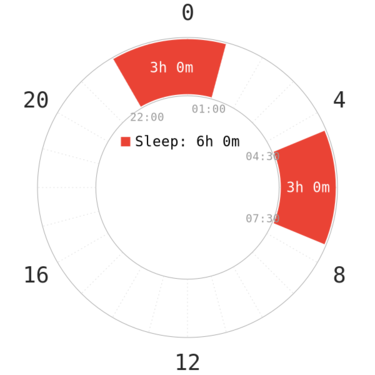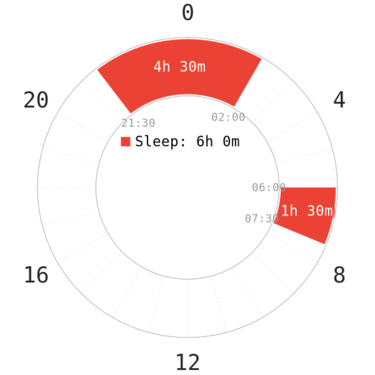Сегментований
| Сегментований | |
|---|---|
| посилання на napchart
Legend
| |
| Час сну | 7 годин |
| Запропоновано | Жоден, використовуваний людьми протягом історії. |
| Складність | Помірна |
| Особливості | 2 довгих ядра вночі, вирівняні до піків SWS та REM відповідно. |
Сегментований - це біфазний графік, що складається з двох ядер вночі, зазвичай із загальним часом сну, близьким до особистого базового рівня на монофазному режимі.
Походження
Сегментований сон є одним з вихідних поліфазних режимів. Це основа лінійки розкладів Dual core. Цей режим був широко поширений в суспільстві до появи електричного освітлення. Сучасні дослідження встановили, що при скороченому фотоперіоді (більш короткому світловому дні) без штучного електричного освітлення людський сон природно сегментований [1].
Люди часто лягали спати через деякий час після заходу сонця, прокидалися через кілька годин, не спали пару годин, а потім знову лягали спати до сходу сонця. Деякі люди з природною схильністю до сегментувати сну повідомляли, що регулярно прокидалися посеред ночі. У подібному випадку хорошим вибором буде перейти на сегментований режим сну.
Механізм
Поліфазне співтовариство в Discord зробило кілька припущень про механізм сегментированного сну. Даний режим багато в чому заснований на піках сну. У ранні години ночі (~21-24), коли починається природна секреція мелатоніну, можна ефективно отримати SWS. Згідно зі свідченнями ЕЕГ адаптованих поліфазніков, перше ядро зазвичай насичено SWS, тоді як друге містить в основному REM. Таким чином, розділені ядра більш щільно вміщають життєво важливі стадії сну, що дозволяє трохи скоротити загальний час сну при стабільному режимі. При подібному графіку можна обійтися без денного непу, оскільки досить довгі ядра вночі зберігають досить легкого сну для підтримки неспання днем.
Обидва ядра за замовчуванням становлять 3,5 години. Спочатку було припущено, що при такій довжині що цикли сну розширюються приблизно до 105 хвилин в порівнянні з ~90-хвилинними циклами при монофазному сні. Це також пояснило б життєздатність графіка, незважаючи на меншу кількість циклів. Однак недавно показання ЕЕГ деяких учасників спільноти показали зворотне.
Проміжок неспання між двома ядрами повинен становити не менше 90 хвилин, при цьому часто рекомендується залишати більш тривалий проміжок (~2,5-3 години). Причина цього в тому, щоб не дати ядрам стати перерваним сном і запобігти труднощі із засипанням або недостатньої продуктивністю.
Адаптація
Для тих, хто схильний до сегментованого сну, адаптація зазвичай проста. У зворотному випадку, вона може бути важче адаптації до Сієсти або E1. Прокидатися після першого ядра і не спати вночі може бути важким. Згодом при неухильному дотриманні графіка ці проблеми повинні зникнути.
Після сегментованого можна піти по шляху поступової адаптації до графіків лінійки Dual core, а також Triphasic, оскільки ви придбали звичку поділу ядер.
Складність
Рівень складності сегментированного сну залежить від людини і від загальної кількості сну на графіку. В цілому, він вважається доброзичливим графіком для новачків.
Варіанти
Хоча варіант з двома 3,5-годинними ядрами за замовчуванням мав найбільший успіх, кілька інших комбінацій також можливі і мали історії успішних адаптацій в минулому. Новачки можуть спробувати ці варіанти з деякими застереженнями.
Загальний час сну 6 годин
Цей модифікований варіант мав певний успіх. Оскільки загальний час сну становить всього 6 годин, він може бути відповідним для тих, чия потреба уві сні на монофазному режимі трохи нижче середнього (~7 годин). Однією з проблем на цьому графіку може бути сонливість опівдні через відсутність непов. Через те, що графік містить менше легкого сну, ніж стандартний, не спати може бути важче.
Проміжок неспання між ядрами повинен становити не менше 4 годин для більш ефективного покриття піків SWS і REM, а також для скорочення тривалості денного проміжку. Адаптація може бути більш складною, ніж стандартна, через скорочення часу сну. Перевага полягає в додатковому часі неспання вночі і відсутності непов днем.
Різниця між розподілом ядер 4.5-1.5 і 3-3 полягає в тому, що ті, у кого вище потреба в SWS, можуть спробувати перший варіант, в той час як ті, кому потрібно приблизно однакову кількість REM і SWS, можуть вибрати другий. В цілому варіант 3-3 краще врівноважує стадії сну і в цілому має більше успіху, ніж варіант 4.5-1.5.
Розширений/Не скорочуючий сон
Також можна розширити цей графік, можливо, до такої міри, що він не буде скорочувати тривалість сну в порівнянні з вихідним сном на монофазному режимі. Це дозволяє легко адаптуватися, зберігаючи при цьому деякі переваги сегментированного сну. Ці графіки також можуть бути корисні тим, у кого підвищена потреба уві сні (~9 годині на монофазному режимі), неповнолітнім і тим, хто регулярно виконує інтенсивні вправи.
Нерівномірна довжина ядер
This variant, which is rarely attempted, has cores of slightly different lengths. These variants allows for slightly more time awake, may be easier to schedule, without a significantly harder adaptation. Other plausible combinations include 3-3.5, or even 4.5-2.5 and 5-1.5. It would be helpful to know the SWS and REM requirements before picking any of these variants, though.
Generally, variants with a longer first core allows for more alertness during core gap, and the second core does not need to be as long. However, the longer the first core, the less "DC-like" it becomes, meaning that the sleep stages becomes less distinctly allocated into the two cores. The longer first core may also resemble Siesta, with the second sleep looking like a daytime core sleep.
Late first core
Sleepers who would schedule this variant are expected to have low SWS needs, and/or a lot of polyphasic experience as well as the stringent management of food, exercise and lighting. This variant is not usually recommended, as the first core being away from SWS peak drastically increases the difficulty. Circadian management is recommended, as with other late-core schedules.
For this variant, the core gap can be smaller than the default, because of the higher SWS pressure prior to core 2.
Siesta-hybrid
The idea behind this variant is similar to Siesta, but with both cores at night, and with the short core providing much of the SWS. Sleepers with lower SWS requirements or want to sleep less around evening hours can attempt this variant.
This variant has recorded at least 2 successes; one attempt was in a winter, where photoperiod was short. The first core becomes a lot shorter than usual, being reduced all the way to only 1 cycle, while the second core is much longer to compensate. Similar ideas can apply to 2.5-4.5 core distribution or so.
The main issue with this is that it is impossible for an average sleeper (90m SWS need) to gain all the needed SWS in the first core, the second core will have to provide the remaining SWS, and pushing the second core to late hours of the night may increase the difficulty of the process.
Similar to the default schedule, this variant also takes away some of the social time in the evening in exchange for time in the core gap.
Alternatively, Segmented may be scheduled with one core at night and another core in the day. Only a few successes have been reported thus far. This variant looks like Siesta with a long daytime core, and both core sleeps miss the peaks. The dark period should be 2-3h before the night core, and continue for ~2h after it to stabilize the circadian rhythm.
Adaptations to this would be much more difficult than a regular Segmented schedule, because skipping both sleep peaks can greatly hinder sleep quality. Over the course of adaptation, staying awake during the graveyard and morning hours will be tough, and having a long sleep in the day may disrupt the circadian rhythm.
Night shift
The idea of this is to have both core sleeps after before work. Alternatively, the daytime core can be earlier so that it is shortly after work. Little is known about this scheduling variant, and adaptations have been overall unsuccessful, due to the large circadian rhythm shift it requires.
There have been several failed attempts Segmented sleep for shift work. This is expected, as overall rates of success are very low for shift workers.
Lifestyle Considerations
Segmented, which allows for a range of schedule options, can be suitable for many. It greatly benefits those who naturally wake up during the night, and also allows those who are unable to take a daytime nap to still sleep polyphasically.
Before one transitions to Segmented, it is important to plan what to do during the core gap. Staying awake with few things to do while everyone else is sleeping can be difficult. For naturally segmented sleepers, this is less of a problem. Here are a few tips:
- Make a list of what activities or tasks that are well suited to being done during the night. This includes entertainment! Being alone can also be an advantage at times. Be sure to consider that these hours must be in dark period, in which you will be wearing goggles, and as such will not be able to differentiate colors.
- Dedicate time for self-care. The core gap can be useful for relaxation after long days at work. Self-care can include autogenic training, meditation, yoga, and stretching. Note that it may be unadvisable to do these things when you are having problems staying awake.
- Plan for your day. People often have a lot to work on and care about. No matter how much extra awake time you might have, time management is always important.
Advantages of Segmented over other schedules include:
- Segmented is the only schedule that easily allows >12h of continuous wake time without needing any naps. This can allow many people who are unable to take naps to sleep polyphasically.
- Segmented offers a relatively high amount tst (total sleep time). It is viable to schedule the first core later than normal, ~23, to allow evening events. The only thing to note, though, is that a late first core likely will delay the end of the second core, and may interfere with your morning activities. Under normal scheduling, however, there will be more limited evening social time on Segmented sleep.
- Segmented can become somewhat flexible after adaptation. Some experienced sleepers have reported being able to flex at least one of the core sleeps. Being able to flex the core sleeps allows for more freedom in controlling the length of core gap to suit one's schedule. For example, on days with little to do, the core gap can shrink down a bit, so that the second core can start earlier than usual, or vice versa. When sudden events occur that would require skipping sleep, Segmented also allows relatively fast recovery afterwards.
- Segmented sleep, especially the extended variant with a longer first core, can support intense physical exercise.
- Vivid dreaming experiences have been reported on the schedule over the years, most of which come from the second core.
References
- ↑ Wehr TA (1992). "In short photoperiods, human sleep is biphasic". Journal of Sleep Research. 1 (2): 103–107. doi:10.1111/j.1365-2869.1992.tb00019.x.






